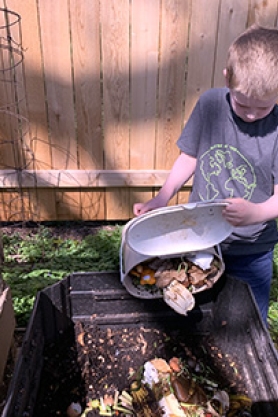Composting in Wisconsin
Compost is an environmentally friendly way to create healthy soil for Wisconsin's landscape. Compost made from yard materials and other organics, like food scraps, can replenish soil with microorganisms and nutrients.
Wisconsin law prohibits landfill disposal of yard materials (also called "yard waste"), including leaves, grass clippings, brush and pieces of wood (branches, sticks, etc.) under 6 inches in diameter. Composting is an easy, inexpensive alternative to landfills that puts these resources to use instead of simply throwing them away.
What Is Compost?
Compost is a soil-like material rich in stabilized carbon produced from the breakdown of organic materials. It is considered a "soil amendment" rather than a fertilizer because it usually contains smaller amounts of nitrogen, phosphorus and potassium than mineral-based commercial fertilizer products.
Benefits of applying compost include:
- restoring or enhancing the ability of sandy soil to hold moisture and clay soils to drain;
- repairing or preventing damage caused by erosion; and
- aiding plant growth – e.g., in residential gardens, public landscapes or after construction and mining projects are completed.
Opportunities to Reduce Food Waste
Because not all food can be composted at home, preventing food waste is also an important step in reducing what goes to landfills. Get tips for preventing food waste:
The U.S. Environmental Protection Agency's interactive Excess Food Opportunities Map identifies sources of excess food and locations of potential recipients of unwanted food, including compost facilities. The map is a tool for communities looking to divert excess food from landfills.
- Learn more about the Excess Food Opportunities Map [exit DNR]
- Launch the Excess Food Opportunities Map [exit DNR]
Wisconsin's Composting Landscape
Today, more than 200 state-licensed composting facilities manage some 200,000 tons of yard materials each year, and hundreds of thousands more tons of yard materials are achieved through home composting and mulching in place.
Wisconsin also generates an additional 500,000 tons of other compostable materials – including food scraps – each year that could be composted and made into useful products. Department of Natural Resources staff are working with nonprofits, local governments and businesses to help them build and expand composting operations in Wisconsin.
Composting can be done at home or on a large scale. More details about home composting are below. For information on state regulations for large-scale composting, see the following resources.
- Composting rules and regulations in Wisconsin
- Farms and composting
- Compost use, quality and marketing
How To Compost At Home
Home composters can make compost in bins or in a heap, though bins are generally a better way to manage the materials. There are a number of home composting containers available commercially, and it is also fairly simple to create your own. The DNR's home composting brochure provides information to get started and tips for experienced composters who want to improve their systems.
There are no current state regulations on small-scale, home composting operations of fewer than 50 cubic yards, but all composting should be done in a nuisance-free and environmentally sound manner. This includes minimizing odors, not attracting excessive numbers of pests and not placing compost piles in wetlands or other sensitive areas. Check with your community to find out if any local regulations apply.
What To Compost
Along with yard materials, certain food scraps can also be easily composted at home. Be sure to follow recommendations on what types of food scraps can be composted at home in order to prevent odors and avoid attracting animals and other pests.
| What to compost | What not to compost |
|---|---|
|
|
Compost subscription services
When backyard composting isn’t possible, subscription services could be the solution. Several services that pick up compostable food waste and food scraps for a fee operate in Wisconsin.
Litterless, a national organization dedicated to fighting climate change and supporting small businesses, tracks which Wisconsin communities have a compost subscription service option.
Composting indoors
Vermicomposting, where red wiggler worms break down food scraps in an indoor bin, takes up minimal space.
Bokashi, an aerobic process where materials are broken down through fermentation, is another alternative. Small indoor systems can be purchased online or through garden stores.
DNR Publications
- Home Composting: The Complete Composter (WA-182)
- Home Composting Materials (WA-1785)
- Home Composting: Reap a Heap of Benefits (WA-072) [PDF] English Version
- Home Composting: Compostaje casero Obtenga un montón de beneficios (Reap a Heap of Benefits) (WA-1480) [PDF] Spanish Version
- Home Composting: Ua chiv tom vaj tom tsev muaj nuj nqis ntawm kev muab txiav, zom los xyaw ua ke (Reap a Heap of Benefits) (WA-1481) [PDF] Hmong Version
- Garbage to Gardens: Compost Grows poster(WA-1528) [PDF 2.8MB]


